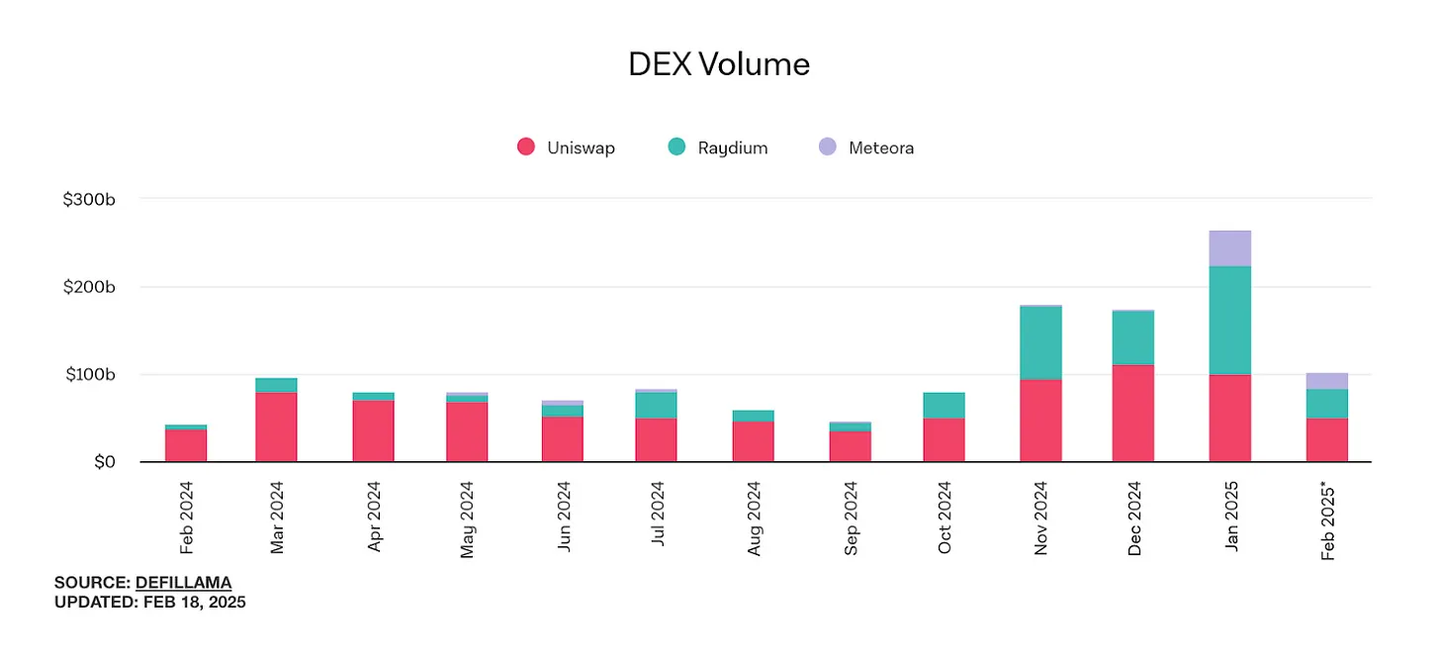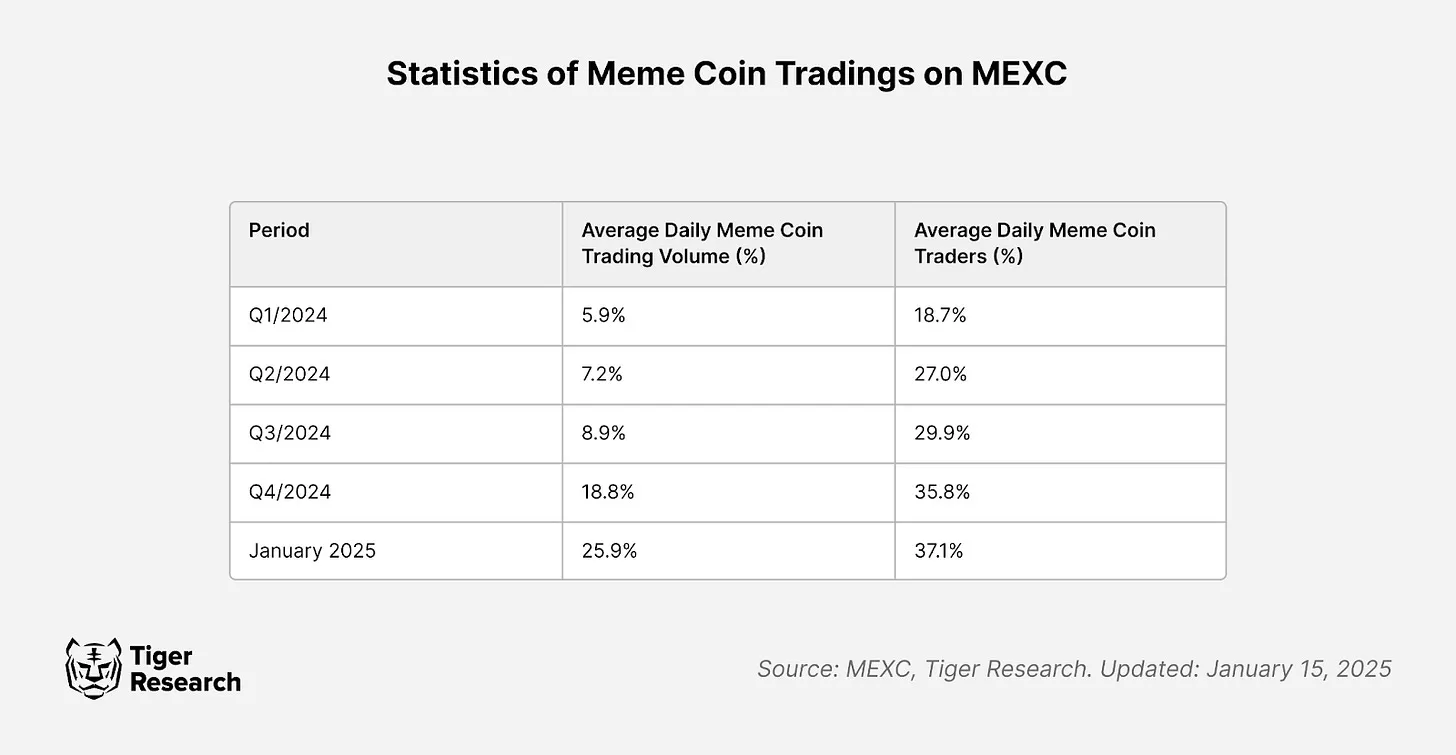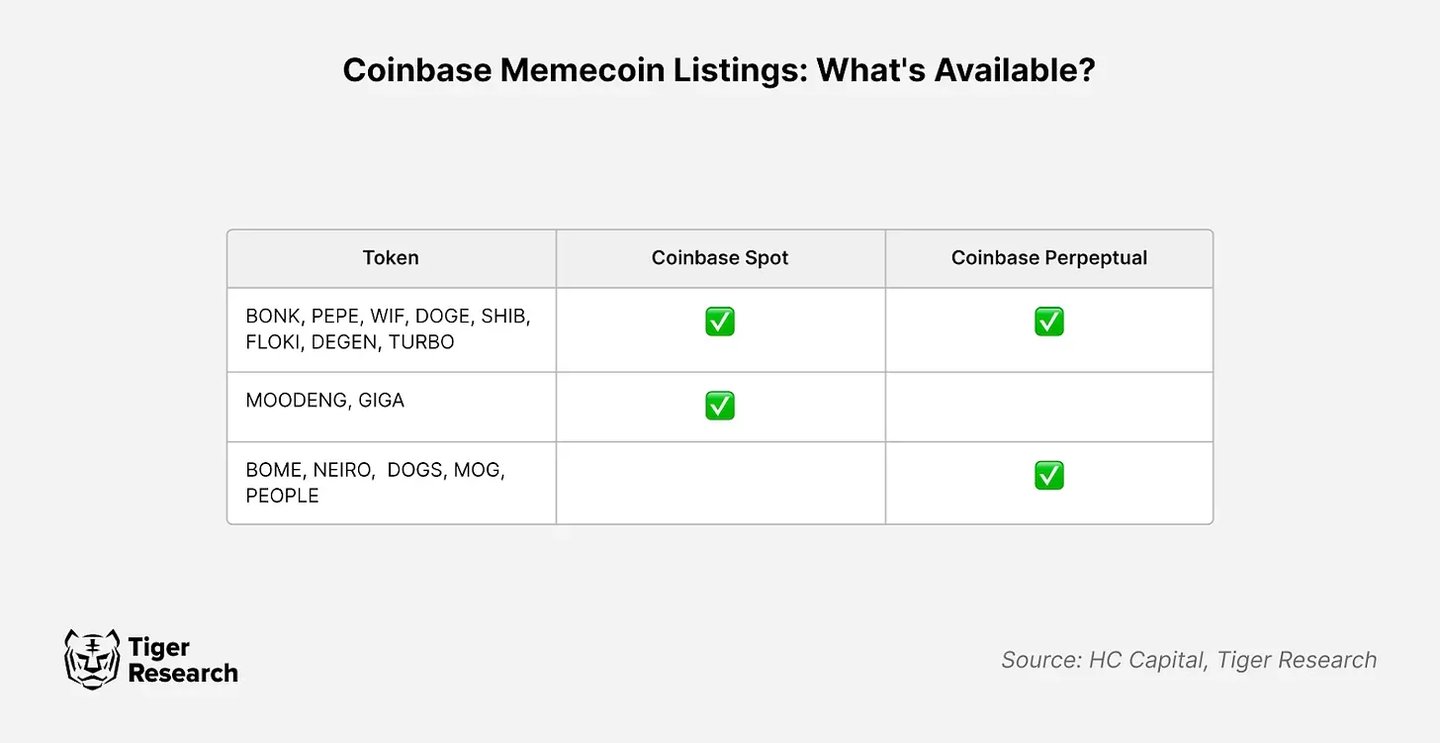Exchanges need to integrate on-chain functions and DeFi elements while ensuring the stability and compliance of the platform.
Written by: Chi Anh, Jay Jo, and Elsa
Translated by: Baihua Blockchain

Key Points Summary
Memecoins have transformed from mere speculative assets into a dominant trading force, attracting significant liquidity and reshaping capital flow patterns in the crypto market.
Platforms like Pump.fun have driven the rise of decentralized exchanges (DEX), attracting liquidity and active traders, thereby undermining the early price discovery capabilities of centralized exchanges (CEX).
Trading platforms that quickly adapt to Memecoins trading, such as MEXC, perform strongly, while slower platforms like BN face dual challenges of liquidity and market influence.
1. The New Battlefield for Trading Platforms
Memecoins are redefining the cryptocurrency market. Starting as a speculative trend, they have now become significant trading varieties on major trading platforms, driving massive trading volumes.
To adapt to this trend, trading platforms are adjusting their strategies. Gate.io and MEXC have captured market share by quickly listing Memecoins, while BN has launched "BN Alpha," focusing on the early listing of Memecoins and providing a smooth transition. In the DEX market, Solana-based Raydium has successfully surpassed Ethereum-based Uniswap to become the market leader. This change demonstrates the powerful driving force of Memecoins in the market.
As the importance of Memecoins on trading platforms continues to rise, their broader impact is also worth noting. Will Memecoins trading lead to a lasting market transformation, or is it merely a transient phenomenon? Additionally, how will changes in regulatory policies affect the sustainability of Memecoins as mainstream assets? These questions will determine the future direction of retail trading and trading platforms.
2. DEX Disrupting the Status Quo: Raydium Surpasses Uniswap
 Source: The Block, DefiLlama
Source: The Block, DefiLlama
The craze for Memecoins has propelled the rapid rise of Raydium. As of January 2025, Raydium has captured 27% of the DEX market share, becoming the preferred platform for retail investors. Raydium's success is attributed to the technical advantages of the Solana chain, which offers lower fees and faster transaction speeds compared to Ethereum-based trading platforms. These features have made Raydium the core platform for Memecoins trading.
Meanwhile, Uniswap's market share has declined from 34.5% in December 2024 to 22% in January 2025, losing its dominant position in the DEX market. High Ethereum gas fees have become a major barrier for Memecoins traders, prompting many cost-sensitive retail investors to turn to other platforms. If Ethereum-based DEXs fail to innovate in a timely manner, they will face greater pressure from liquidity shifts.
Although Memecoins trading has clearly driven Raydium's growth, the sustainability of this trend remains to be seen. Some analysts believe that as speculative demand decreases, the Memecoins trading frenzy may gradually fade. However, Raydium has become a familiar platform for users through Memecoins trading. If it can seize this trend, Raydium is expected to further solidify its market position by strengthening liquidity pools, optimizing user experience, and building an efficient trading system. These efforts will help Raydium maintain a long-term advantage in the competition between DEX and CEX.
3. CEX's Response: Can They Keep Up with the Rise of DEX?

Gate.io and MEXC have successfully attracted a large number of retail investors interested in speculative assets by focusing on the listing strategy for Memecoins. Among them, MEXC has become a leader in this trend with its rapid Memecoins listing policy. For example, they opened trading on the same day as the listing of Memecoins Official Trump ($TRUMP), which directly led to record trading volumes and rapid growth in user numbers.
These strategies have produced significant results. MEXC's daily Memecoins trading volume surged from 5.9% in Q1 2024 to 25.9% in January 2025. Meanwhile, the proportion of Memecoins traders increased from 18.7% to 37.1%.

As the world's largest cryptocurrency trading platform, BN is also actively expanding its range of Memecoins listings to attract retail liquidity. Recently, BN has focused more on speculative assets, attempting to seize market opportunities in the "attention economy." However, due to its nature as a centralized exchange (CEX), BN is inevitably constrained by internal review processes. These processes often result in Memecoins being listed only after market enthusiasm has waned or shifted to new trends.
While BN provides ample liquidity to protect investors, this liquidity has become an outlet for early holders to sell off Memecoins. Since the impact of sell-offs on market prices is minimal, many newly listed Memecoins have seen their prices drop by over 75% in the short term, leading to significant losses for many investors. This situation not only damages BN's long-term reputation but also raises questions about its listing review processes.

In contrast, major centralized trading platforms like Coinbase, Kraken, and Upbit have adopted a more conservative strategy, focusing on verified cryptocurrencies rather than Memecoins. While this strategy may miss short-term high-yield market opportunities, it helps maintain platform stability and reduce regulatory risks.
In recent years, the trend of funds flowing from CEX to DEX has become increasingly evident, indicating that CEX no longer holds absolute market dominance. In light of this change, CEXs need to reassess their strategic layout. They can choose from several approaches:
Filter early assets and provide transparent information (e.g., BN Alpha);
Manage risks through selective Memecoins listings;
Introduce a hybrid trading model that combines on-chain order books with DeFi elements.
Nevertheless, Memecoins continue to demonstrate their potential in the crypto space. They are gradually becoming representative assets for certain entities and groups. For instance, the relationship between Elon Musk and Dogecoin, the association of Trump with the Official Trump Token, and cases of Memecoins issued by some startups and countries all indicate that cryptocurrencies are capturing real economic and social value. This trend bears similarities to the securitization process in traditional financial markets and may gradually evolve into a new cultural phenomenon.
In response to this change, CEXs must quickly adjust their strategies. Investors are no longer waiting for CEX listings to start trading promising assets. To attract more users and remain competitive, trading platforms need to integrate on-chain functions and DeFi elements while ensuring platform stability and compliance. This flexible and innovative strategy will be key to driving the crypto market into the next growth phase.
The current core challenge for CEXs is how to balance attracting short-term trading activity with maintaining long-term platform stability while retaining the trust of institutional investors and effectively attracting more retail investors.
4. Strategic Summary and Future Prospects
Memecoins have evolved from mere speculative tools into significant trading varieties in the cryptocurrency market. With a substantial increase in Memecoins trading volume on decentralized exchanges (DEX), this trend brings new opportunities and challenges to the crypto industry.
In the recent bull market, Memecoins on DEXs have significantly outperformed assets listed on centralized exchanges (CEX), prompting more and more investors to turn to DEXs. Platforms like Pump.fun have optimized the issuance and trading processes of Memecoins, allowing new tokens to achieve explosive growth even without being listed on CEXs.
To adapt to this change, market makers, liquidity providers, and project teams are adjusting their strategies. They are no longer solely focused on CEX listings but are beginning to value the DEX environment. By establishing liquidity pools across multiple platforms, they have enhanced the accessibility and flexibility of trading.
However, the Memecoins market still faces numerous risks. Unethical behaviors such as exit scams, manipulation by small groups, and malicious trading severely harm investors' interests. Due to the lack of effective regulation in the market, these issues are prevalent. For example, the Argentina Libra ($LIBRA) scandal exposed these potential risks, leading to widespread skepticism about Memecoins and a significant decline in trading volume on Solana DEX.
Despite this, Memecoins continue to showcase their potential in the crypto space. They are gradually becoming representative assets for certain entities and groups. For instance, the relationship between Elon Musk and Dogecoin, the association of Trump with the Official Trump Token, and cases of Memecoins issued by some startups and countries all indicate that cryptocurrencies are capturing real economic and social value. This trend bears similarities to the securitization process in traditional financial markets and may gradually evolve into a new cultural phenomenon.
In response to this change, CEXs must quickly adjust their strategies. Investors are no longer waiting for CEX listings to start trading promising assets. To attract more users and remain competitive, trading platforms need to integrate on-chain functions and DeFi elements while ensuring platform stability and compliance. This flexible and innovative strategy will be key to driving the crypto market into the next growth phase.
免责声明:本文章仅代表作者个人观点,不代表本平台的立场和观点。本文章仅供信息分享,不构成对任何人的任何投资建议。用户与作者之间的任何争议,与本平台无关。如网页中刊载的文章或图片涉及侵权,请提供相关的权利证明和身份证明发送邮件到support@aicoin.com,本平台相关工作人员将会进行核查。




